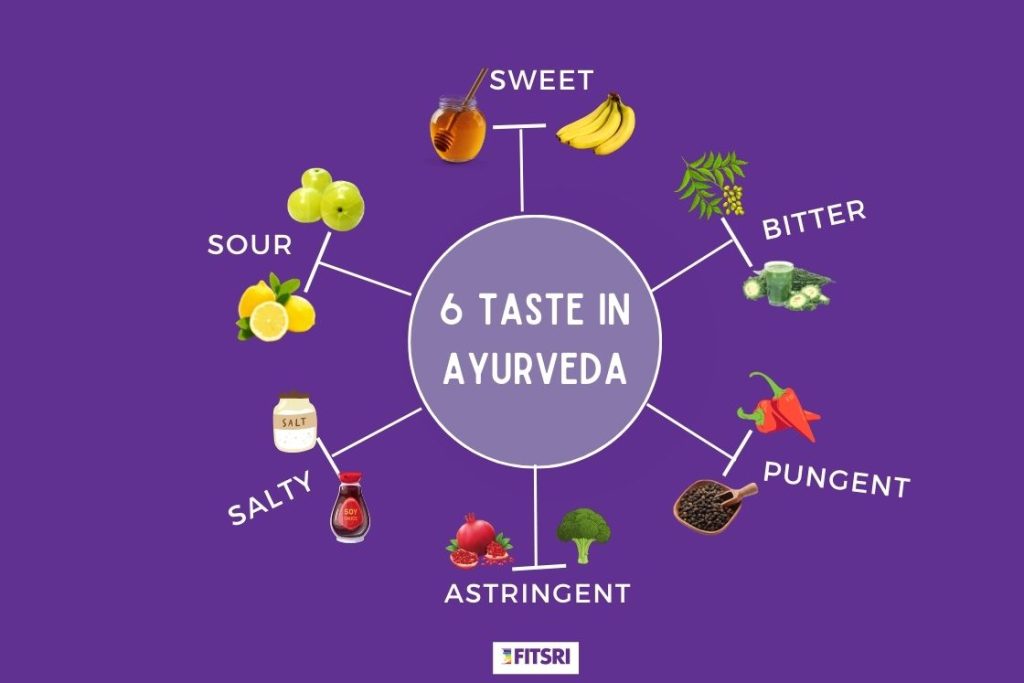
Since food communicates with us through taste, Ayurveda considers the sense of taste as a guide to healthy eating. Through this sense of taste, we can truly access the body’s own knowledge about nutrition and food.
The five components that make up the doshas — space, air, fire, water and earth — also make up taste. In addition, Vata, Pitta and Kapha are affected by each flavor.
Sweet, sour, salty, bitter, pungent and astringent are the six basic tastes (rasas) in Ayurveda. Ayurvedic dietary principles emphasize that every meal should ideally contain all six of these tastes. By doing this and adjusting the proportions to your individual constitution, you can promote proper nutrition, satiety, and the maintenance of a balanced constitution, contributing to overall well-being and harmony.
Relationship Between Taste and Digestion
Taste also plays an important role in the digestive process.
The first thing that impresses us about food when it enters our mouth is its taste. According to Ayurveda, the digestion process begins as soon as you put the food in your mouth
Enzymes found in the saliva of the mouth help convert food into carbohydrates before it is swallowed. When the brain recognizes one of the six tastes, it stimulates the intestines or digestive tract to secrete the enzymes needed for efficient digestion. For the same reason, we are constantly encouraged to eat mindfully and enjoy every bite of our meal.
According to Ayurveda, every meal should contain all six flavors. Depending on the Prakriti, Vikriti and season, an appropriate diet contains the right amount of each of the six flavors.
Know Your Body Type: Join Our Online Ayurveda Workshop
Your brain will tell your body to keep eating if it thinks you aren’t eating enough different kinds of foods. If you eat only one type of food, you’ll overeat. You’ll not feel satiated after the meal because it’s not balanced enough.
All body systems are brought into balance when each flavor is used individually or together in the right amount, leading to happiness and health for all living beings.
Let’s look at the different properties of each flavor and how they affect the doshas.
1. Sweet (Madhur)
- Elemental Constitution – Earth and Water
- Favorable Dosha – Vata, Pitta
- Aggravating Dosha – Kapha
Sweetness is considered the most stabilizing and nourishing of the six tastes. It is known as madhura, which means pleasant, endearing, lovely, soothing, musical, and sweet. Because of its cooling, warming, and oily properties, sweet taste, which is mainly water and earth, is beneficial for balancing vata and pitta.
Because of its heavy, fatty, and moist properties, this is the flavor to emphasize in your diet if you are trying to gain weight. Enjoyed in moderation, it promotes longevity, strength, and healthy physiological fluids and tissues. It rejuvenates skin and hair, balances pitta fire, and gives life and energy to the body.
The flavor of energy is sweet and comes from a variety of naturally occurring sugars. Complex carbohydrates and sweeteners (in moderation) are the best sources of sweetness as they are easier to digest and have fewer post-digestion side effects.
Sweet meals can relieve constipation and minimize dehydration by improving the body’s water balance. In addition, sugary foods can soothe mucous membranes, support hormone regulation, and improve skin appearance. Excessive consumption can also affect mood and slow digestion. All things kapha, including mucus, fat, and plasma tissue, can accumulate with overindulgence in sweets.
Examples of Sweet Foods
Sweet fruits, starchy vegetables, grains, wheat goods, dairy products, and natural sweeteners like honey and maple syrup are the main sources of sugar.
Some examples of sweet foods are:
- Wheat (unprocessed), rice
- Dairy, Goat Milk, Butter (salted)
- Coconut Water
- Raw Honey, Jaggery
- Dates
- Pumpkins, Licorice root, Beets, Rhubarb
- beans, black gram, green gram, and lentils
- Anchovy, Lobster
- Sweet Potato, Summer Squash
- Beef, Chicken Liver, Duck, Eggs, Lamb
- Cashews, Chestnuts
- Garlic
- Apple (cooked), Banana, Kiwi, Mango, Orange, Papaya, Peaches, Pineapple, Plum, Strawberries
- Sesame Seeds, Tahini, Tamarind
2. Sour (Amla)
- Elemental Constitution – Earth and Fire
- Favorable Dosha – Vata
- Aggravating Dosha – Kapha, Pitta
Amla represents something sour, acidic and easily fermented. It can help with cleansing and digestion as it is light, warming and oily. Amla not only stimulates salivation and appetite, but also has a balancing effect on acidity due to its light, warm and oily properties.
The sour taste stimulates the intellect, thoughts and feelings and also promotes appreciation, discrimination and attention span. It can improve digestion, elimination and the feeling of hunger.
It reduces Vata while strengthening Pitta and Kapha.
Thank you to the support of the digestive process by acidic foods, your body can metabolize food faster. In addition, acidic foods can stimulate the circulatory system and stimulate the body.
They also eliminate excess vata, reduce liver congestion, stimulate healthy bile flow and support liver function. The vitamin C content of sour fruits is often high, and they are often found to be restorative.
Eating too much of it can increase pitta and cause hyperacidity, so it must be consumed in moderation. Vatas typically have weak digestive fire, so amla is very balanced for them. Kaphas should limit the amount of acidic foods in their meals, while pittas should stay away from them. A diet that contains too much acid can aggravate eczema flare-ups and lead to hyperacidity, diarrhea, and excessive thirst.
Examples of Sour Foods
Organic acids in food are what give them their sour flavor. It must be used in limit or otherwise, the body may quickly become aggressive.
Some examples of sour foods are:
- Sour cream, yogurt, vinegar, cottage cheese, feta, buttermilk
- Raw apples, green mango, pomegranate, cherries
- Citrus fruits, Grapefruit, lemon, lime, raisins
- Tomatoes
- Sourdough bread
- Pickles, tomatoes
- Butter, cheese, sour cream, yogurt
- Alcohol, vinegar, most fermented foods
- Lemon juice, lime juice, garlic, savory
- Soy sauce, miso
3.Salty (Lavana)
- Elemental Constitution – Water and Fire
- Favorable Dosha – Vata
- Aggravating Dosha – Kapha, Pitta
Heating, heavy, greasy and hydrophilic are all properties of salty flavor. Its grounding and moisturizing properties calm Vata when used mildly, but increase Kapha and Pitta. Ayurveda states that salt is mainly fire and only a small amount of water.
It is often used in conjunction with other flavors to help restore fluids. Lavana rasa helps the body stay warm and aids digestion, similar to Amla rasa. The nervous system finds stability and a sense of foundation in the taste of salt.
Salt not only adds flavor to food, but also speeds digestion, aids electrolyte balance, purifies tissues, and promotes the absorption of minerals. It strengthens courage, self-confidence and spirit.
On the other hand, too much salt consumption leads to sodium retention, thickens the blood and constricts blood vessels, which in turn increases blood pressure. It can also cause premature graying and hair loss, and make us thirsty.
Examples of Salty Foods
The food’s mineral salts are what give it its taste. Some examples of salty foods are:
- Seaweed, Kelp
- Natural Mineral salt, rock salt, Black Salt
- Celery, black olives
- Soy sauce, tamari, miso
- Anchovy, Mussels, Oyster, Tuna
- Blue Cheese, Cheddar Cheese, Feta Cheese, Mozzarella Cheese, Parmesan Cheese
4.Pungent/Spicy (Katu)
- Elemental Constitution – Fire and Air
- Favorable Dosha – Kapha
- Aggravating Dosha – Pitta, Vata
A pungent taste is strong, acute and quickly enveloping. It causes a slight feeling of warmth on the tongue, throat and chest. Spicy food is the hottest of all rasas and aggravates pitta and balances kapha.
When spicy flavors are paired with sour, sweet or salty foods, Vata can absorb them effectively. When you eat spicy foods, you may think more quickly and logically, and absorb complex concepts more easily.
it enhance digestion and absorption, cleanses the mouth and inflames agni when used judiciously. By promoting nasal secretion and reducing kapha, it also helps clear the sinuses. Circulation is stimulated and body fat and blockages are dissolved.
In addition, it promotes perspiration, cleanses the internal pathways and purifies the blood and muscles.
However, eating spicy foods can cause discomfort, heartburn and nausea. It might cause you to be overly biassed.
Examples of Pungent Foods
The foods’ essential oils are what give them their flavor. There are many gentler pungent tastes available; it doesn’t necessarily indicate chilies, as is typically assumed.
Some examples of pungent/spicy foods are:
- cayenne pepper, chili, black pepper. Paprika, jalapeno peppers
- Buckwheat, Spelt
- Mustard seeds, mustard greens
- Ginger, onion, garlic
- Vinegar
- curry leaves, cinnamon, cumin, cloves, allspice, anise, coriander, marjoram
- leeks, kohlrabi, radishes, turnips, wasabi
- raw spinach, chives
5.Bitter (Tikta)
- Elemental Constitution – Air and Ether
- Favorable Dosha – Pitta, Kapha
- Aggravating Dosha – Vata
The dry, light qualities of the bitter taste ignite the digestive fire and have a digestive effect. Of all the tastes, it is considered the coolest and lightest, making it good for Pitta and Kapha and least helpful for Vata.
Because the bitter taste eliminates fat and impurities, it has a profound cleansing effect on the body. It enhances all other tastes, quenches thirst, increases appetite and cleanses the gastrointestinal tract.
It helps to remove excess moisture from the body, reduce heat, detoxify and strengthen the liver, and purify the blood. It also tones the skin and muscles and relieves sporadic skin pain.
Bitter foods rid the body of zeal and seductive feelings, thus also helping to purify the mind.
This is not a distinct taste, but an effect that is openly acknowledged. Usually people do not have the desire to eat much of it because of the taste.
Overeating can cause gas to build up in the digestive tract. In addition, it can lead to an abnormally high level of cold as well as discomfort, dizziness and disorientation. This is because the ether element of bitter taste creates space by removing excess fluid.
The dryness can cause the tongue to appear excessively dry and the tissues to feel exhausted
Examples of Pungent Foods
Alkaloids or glycosides in the food are what give it its bitter flavor. Some good examples of bitter foods are:
- Cumin, dill, fenugreek, saffron, turmeric
- Aloe vera, Neem
- Bitter melon, burdock root,
- Zucchini, Bitter gourd,
- Leafy greens like kale, collards, dandelion greens, spinach, salad leaves
- Green cabbage, sprouts, parsley
- Eggplant, Jerusalem artichokes
- Sesame seeds, sesame oil, coffee, dark chocolate
6.Astringent (Kashaya)
- Elemental Constitution – Air and Earth
- Favorable Dosha – Pitta, Kapha
- Aggravating Dosha – Vata
The nature of Kashaya is heavy, drying and cooling. Vata is increased while pitta and kapha are decreased. The tonic properties of the astringent taste make it an excellent remedy for diarrhea and promote absorption.
It causes the mouth to feel chalky or dry and wrinkled.
The coldness of the astringent flavor is very beneficial for Pitta, while the dry, light properties of this flavor balance Kapha.
It has a decongestant effect and supports proper nutrient absorption. Its anti-inflammatory properties support wound healing and soothe the stomach. It promotes clotting, which stops bleeding, and helps heal ulcers.
The astringent flavor helps remove extra moisture, cleanse mucous membranes and remove grease. The binding nature of astringent flavor compresses and holds tissues together, promoting cohesion of the body. Astringent flavor is a very effective tool to promote the formation and removal of bodily secretions such as sweat, feces and urine.
When eaten in excess, it might lead to constipation. In addition, it may lead to aches in the muscles and joints, poor circulation, blood and lymphatic congestion, sleep problems, emotional heaviness, and anxiety.
Vata-dominant individuals should consume the astringent taste in moderation as it may lead to gas formation.
Examples of Astringent Foods
Food tannins are the source of flavor. Even though we don’t require much of this flavor, we won’t be content without it. Several ayurvedic herbs have a bitter taste because they either directly or indirectly support digestion.
Examples of some astringent foods are as follows:
- Unripe bananas, pomegranates, apples, Cranberries, pears, figs
- Chickpeas, green beans, peas
- Okra
- Alfalfa sprouts, avocado
- broccoli, brussels sprouts, cabbage, lettuce
- Carrots (raw), cauliflower,
- Potatoes
- Asparagus, turnip
- Raw vegetables
- Basil, bay leaf, caraway, coriander
- Rye, buckwheat
- Dill, fennel, marjoram, nutmeg
- Oregano, parsley, rosemary
- Poppy seeds
- Saffron, turmeric, vanilla
Conclusion
According to conventional nutritional thinking, all vital nutrients are covered by the 6 flavors. The body naturally prefers flavors that are in harmony with the doshas it was born with and rejects flavors that aggravate it. We are guided to the right foods if we simply follow our instincts.





Hello There,
Thank you for sharing this knowledge with us. If you could provide some scientific references for this information, I would be extremely appreciative.